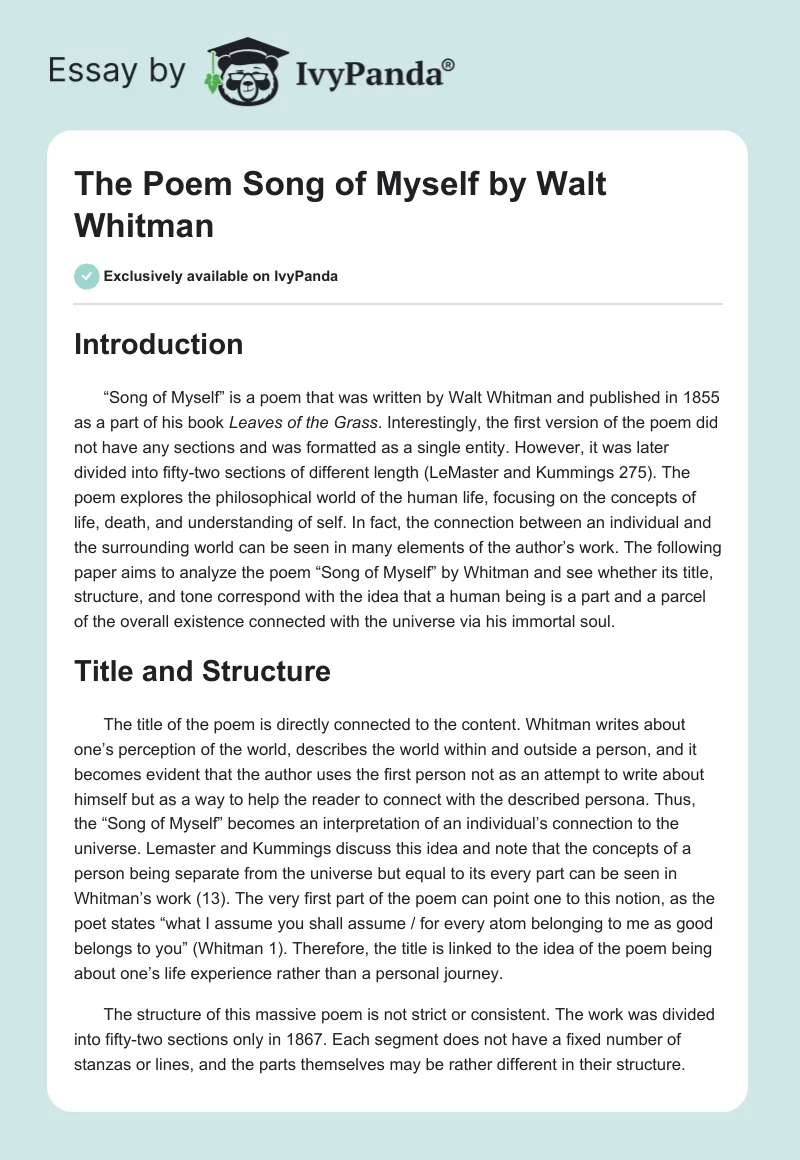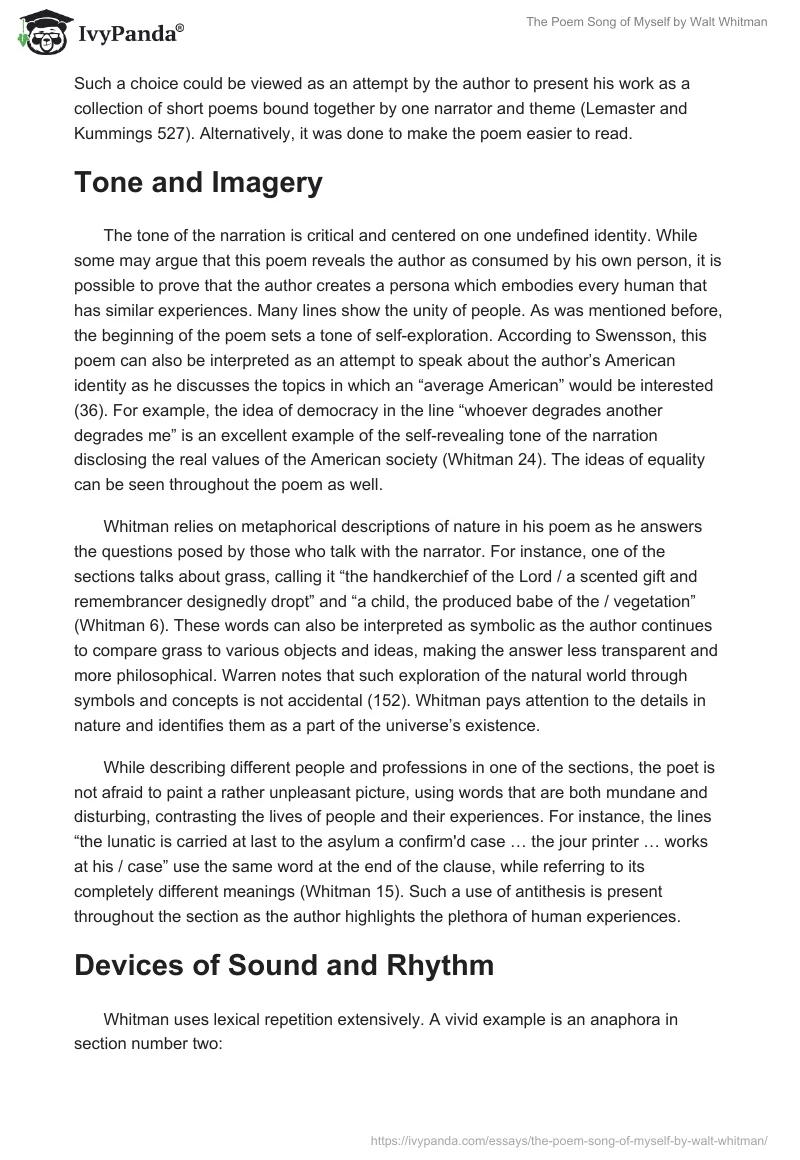Introduction
“Song of Myself” is a poem that was written by Walt Whitman and published in 1855 as a part of his book Leaves of the Grass. Interestingly, the first version of the poem did not have any sections and was formatted as a single entity. However, it was later divided into fifty-two sections of different length (LeMaster and Kummings 275).
The poem explores the philosophical world of the human life, focusing on the concepts of life, death, and understanding of self. In fact, the connection between an individual and the surrounding world can be seen in many elements of the author’s work. The following paper aims to analyze the poem “Song of Myself” by Whitman and see whether its title, structure, and tone correspond with the idea that a human being is a part and a parcel of the overall existence connected with the universe via his immortal soul.
Title and Structure
The title of the poem is directly connected to the content. Whitman writes about one’s perception of the world, describes the world within and outside a person, and it becomes evident that the author uses the first person not as an attempt to write about himself but as a way to help the reader to connect with the described persona. Thus, the “Song of Myself” becomes an interpretation of an individual’s connection to the universe.
Lemaster and Kummings discuss this idea and note that the concepts of a person being separate from the universe but equal to its every part can be seen in Whitman’s work (13). The very first part of the poem can point one to this notion, as the poet states “what I assume you shall assume / for every atom belonging to me as good belongs to you” (Whitman 1). Therefore, the title is linked to the idea of the poem being about one’s life experience rather than a personal journey.
The structure of this massive poem is not strict or consistent. The work was divided into fifty-two sections only in 1867. Each segment does not have a fixed number of stanzas or lines, and the parts themselves may be rather different in their structure. Such a choice could be viewed as an attempt by the author to present his work as a collection of short poems bound together by one narrator and theme (Lemaster and Kummings 527). Alternatively, it was done to make the poem easier to read.
Tone and Imagery
The tone of the narration is critical and centered on one undefined identity. While some may argue that this poem reveals the author as consumed by his own person, it is possible to prove that the author creates a persona which embodies every human that has similar experiences. Many lines show the unity of people. As was mentioned before, the beginning of the poem sets a tone of self-exploration.
According to Swensson, this poem can also be interpreted as an attempt to speak about the author’s American identity as he discusses the topics in which an “average American” would be interested (36). For example, the idea of democracy in the line “whoever degrades another degrades me” is an excellent example of the self-revealing tone of the narration disclosing the real values of the American society (Whitman 24). The ideas of equality can be seen throughout the poem as well.
Whitman relies on metaphorical descriptions of nature in his poem as he answers the questions posed by those who talk with the narrator. For instance, one of the sections talks about grass, calling it “the handkerchief of the Lord / a scented gift and remembrancer designedly dropt” and “a child, the produced babe of the / vegetation” (Whitman 6). These words can also be interpreted as symbolic as the author continues to compare grass to various objects and ideas, making the answer less transparent and more philosophical. Warren notes that such exploration of the natural world through symbols and concepts is not accidental (152). Whitman pays attention to the details in nature and identifies them as a part of the universe’s existence.
While describing different people and professions in one of the sections, the poet is not afraid to paint a rather unpleasant picture, using words that are both mundane and disturbing, contrasting the lives of people and their experiences. For instance, the lines “the lunatic is carried at last to the asylum a confirm’d case … the jour printer … works at his / case” use the same word at the end of the clause, while referring to its completely different meanings (Whitman 15). Such a use of antithesis is present throughout the section as the author highlights the plethora of human experiences.
Devices of Sound and Rhythm
Whitman uses lexical repetition extensively. A vivid example is an anaphora in section number two:
You shall possess the good of the earth and sun …
You shall no longer take things at second or third hand …
You shall not look through my eyes either, nor take things …
You shall listen to all sides and filter them from your self. (Whitman 2)
Here, the repetition of “you shall” at the beginning of each line is used to structure the thoughts of the narrator. Another similar example of anaphora is present in the second section. The questions that start with the words “have you reckon’d” present a number of questions for the reader and create a sense of intimacy and interaction. The connection of the words with the device of lexical repetition makes this form of address somewhat invasive and persistent. In this part, the borderline between the poet and the reader is getting transparent and, in the end, vanishes altogether.
Whitman uses epiphora as well, ending multiple clauses with the word “perfume” in the second section. Multiple repetitions can also be found in the third section, where the author uses the word “urge” to create tension. Different types of repetition also function on the level of perception influencing the reader with words and sounds and making him or her experience the same feelings that the narrator is describing. Greene points out that Whitman has a peculiar sense of sequence, stating that the poet often structures the poem in a way that its events feel simultaneous and omnipresent to the reader (137). The flow of the poem resembles an internal monologue.
The devices of sound contribute a lot to the coherence and cohesion of the phonetic form of the poem. The author uses alliteration – “the smallest sprout shows…” and assonance – “my tongue, every atom of my blood” throughout the poem (Whitman 6; Whitman 1). The poem belongs to the blank verse type and does not reveal any rhyming scheme. The syllabic division and meter are not expressed on a regular basis. The use of rhyme is occasional and can easily go unnoticed for some readers.
Theme
The poem by Whitman is wholly devoted to human life in the background of nature and society. By celebrating himself through the narrator, the poet celebrates the universe and the identity of his peers and humans in general. Thus, the theme of the poem is a lifelong journey of human existence based on one’s personal, social and cultural traits.
Gaillard also notes the ideas of human body and soul in the poem, arguing that these concepts are united in Whitman’s work (par. 14). The union of the narrator and the audience enables the reader to perceive the poem from the inside of the author’s thinking process, rather than from an outsider’s point of view. This creative collaboration between the poet and the reader makes the first line of the poem not arrogant but empathetic.
Critique
The poem “Song of Myself” has been a subject of diverse criticism. For instance, Abid et al. see the poem as “a joyous celebration of the human self in its most expanded, spontaneous, self-sufficient, and allembracing state,” noting that the themes of democracy, self-identification, and spirituality are prevalent in Whitman’s work (113). This critique explores the symbols present in the poet’s writing and states that the effect of nature on the human body and soul is nurturing and soothing as the authors see a positive depiction of different ages and periods of human life in the poem.
The second example comes from Feder, who discusses the personality that the poet creates in his work. The critic argues that the use of long lines and descriptions, which are prevalent in the poem, are excessive and unnecessary. Feder states that “the spillage of line upon line, the seeming trillions” complicates the narration, makes the main point of the poem vague, and confuses the reader (199). However, the author points out the theme of infinity and discusses Whitman’s use of literary devices to support the idea of time progression.
Works Cited
Abid, Maratab, et al. “Critical Analysis of Walt Whitman and Philip Larkin as Modern Poets.” Language in India, vol. 16, no. 9, 2016, pp. 106-116.
Feder, Rachel. “Practicing Infinity.” Walt Whitman Quarterly Review, vol. 34, no. 2, 2016, pp. 195-200.
Gaillard, Hélène. “Singing and Painting the Body: Walt Whitman and Thomas Eakins’ Approach to Corporeality.” Miranda, vol. 15, 2017, Web.
Greene, Roland. Post-Petrarchism: Origins and Innovations of the Western Lyric Sequence. Princeton University Press, 2014.
LeMaster, J. R., and Donald D. Kummings, editors. The Routledge Encyclopedia of Walt Whitman. Routledge, 2013.
Swensson, Eleanor S. “One Nation, Two Voices: Whitman, Dickinson and the Combined Call of American Poet and Prophet.” Articulāte, vol. 16, 2017, pp. 33-42.
Warren, James Perrin. “Gerhardt, Christine, A Place for Humility: Whitman, Dickinson, and the Natural World.” Walt Whitman Quarterly Review, vol. 32, no. 3, 2015, pp. 151-153.
Whitman, Walt. “Song of Myself.” University of Illinois, Web.

 4.00
4.00
